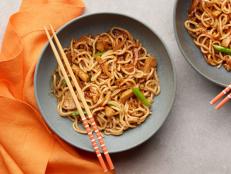13 Different Ways the World Eats Pasta
Here’s how countries around the globe adapted this Italian staple.

Tatna Maramygina / EyeEm/Getty
Pasta is one of the most popular categories of foods in the United States. According to a 2013 study, more than half of Americans eat some kind of pasta or noodle at least once a week, and the majority of those people (about 79%) prefer Italian-style pastas. We have Italian immigrants and their descendants to thank for introducing us to this Italian staple and the many traditional ways of preparing and enjoying it – from cookbook authors and restaurant owners to TV personalities, friends and neighbors. Over time, we’ve even come up with some American originals like spaghetti and meatballs, Cajun chicken pasta and chili mac. However, we’re not the only ones who have developed unique Italian-inspired dishes adapted to local tastes and available ingredients. There is a world of pasta waiting for you to explore.
Carbonara a la francaise
Pasta dishes are very popular in France, and in some regions, like Provence, they’re actually a traditional part of the local cuisine. Carbonara a la francaise literally means French-style carbonara and is a very French interpretation of this classic Italian dish. In this version, the guanciale or pancetta is replaced with French ham, while the signature sauce is made richer with creme fraiche, a cultured cream similar to sour cream.
Makaronia me Kima
If you’ve ever enjoyed a plate of spaghetti smothered in Cincinnati-style chili this dish may taste very familiar. Makaronia me Kima is a Greek dish that means spaghetti with minced meat. The meat sauce is flavored with cinnamon, cloves, cardamom and other spices that are favored in Greek cuisine and found in other dishes like moussaka and pastitsio. This dish was the inspiration for modern-day Cincinnati chili, which was invented by Greek immigrants.
Makaroni po Flotski
This is a simple Russian take on pasta with meat sauce that originated in the Russian navy’s mess halls. The name translates to Navy Pasta. It later became popular with the general population because it was filling, nutritious, easy to prepare and inexpensive. Basically comprised of macaroni, ground meat, onions and simple seasonings, it’s something that households could easily whip up and is still a popular homecooked meal today.
Makrouna
During World War II, Italian troops occupied the North African nation of Tunisia, which was a French colony at the time. However, Italians had been living and eating in modern-day Tunisia since the 1800s. Their presence led to the creation of a Tunisian-style pasta dish called Makrouna. What makes the dish special is the lamb, beef or chicken braised in a spicy tomato sauce perfumed with north African spices, which can include ras-al-hanout and harissa.
Baasto iyo Sugo
If you speak Italian, you may recognize part of the name of this Somali dish. Sugo translates to meat sauce, while baasto translates to pasta in Somali. The similarity between the Italian and Somali words is not a coincidence, though. This dish developed during the Italian occupation of Somalia in World War II. Locals adapted Italian-style pasta and meat sauce by adding chilis, fresh cilantro and an aromatic spice blend called xawaash. The most distinct part of this dish, however, is that it’s typically eaten with a ripe banana, making for a sweet and savory combination.
Jollof Spaghetti
Jollof rice is a wildly popular and insanely delicious rice dish from West Africa. It originated with the Wolof people in modern-day Senegal but soon spread throughout the region, and many West African countries claim they make the best version. In Nigeria, imaginative cooks started preparing spaghetti with Jollof seasonings and ingredients, and a new favorite was born. Seasonings can vary from cook to cook, but the sauce usually contains tomato, onion and chilies. Some versions are seasoned with hot Madras curry powder. The meat can vary, or you can leave it out altogether.
Spaghetti Napolitan
This spaghetti dish is part of the yoshoku style of Japanese cooking, which translates to “Western food.” This style of cuisine originated as a result of Japan opening its borders in the latter half of the 19th century. New foods and ideas entered the country, and local cooks began adapting European and American foods to Japanese tastes. Spaghetti Napolitan was an early Japanese interpretation of Italian spaghetti using ketchup and hot dogs or Vienna sausages, which were introduced by U.S. troops after World War II. It is still popular today at specialized Yoshoku restaurants in Japan and abroad.
Baked Spaghetti Bolognese
Hong Kong also has its versions of Western-style dishes adapted to local tastes, which you can find at tea houses called cha chaan tengs. A popular dish at these establishments is spaghetti with a sweet ground meat sauce with ketchup and sometimes a few typical Cantonese ingredients, like soy sauce and rice wine. The pasta is usually baked in a casserole under a layer of cheese, making it a luscious favorite among locals and visitors. Cha chaan tengs also feature other pasta dishes, like porkchops on pasta or curry on pasta.
Filipino Spaghetti
When U.S. troops occupied the Philippines after World War II, they introduced the local population to many American processed foods, including pasta, hot dogs and ketchup. In the 1940s, Filipinos started mass producing their own local variety of ketchup made from bananas, since tomatoes were scarce and American ketchup was expensive to import. Contemporary Filipino spaghetti is sweet thanks to its banana ketchup base. Some cooks include ground meat, but almost everyone agrees that sliced hot dogs are a must. The dish is typically finished with grated processed cheese that melts into the sauce, creating a creamy mixture. This dish is such a beloved part of Filipino cuisine, that it is even offered as a side dish at Filipino fast food restaurants, like Jollibee.
Espagueti Napolitana
Cuban-style pizzerias are a thing in both Cuba and Miami, Florida. Besides thick, fluffy pizzas, these restaurants also feature pasta dishes. For some Cubans, a pizzeria experience is incomplete without a plate of espagueti (a phonetic spelling of how Spanish speakers pronounce spaghetti) napolitana. It’s a simple dish of spaghetti noodles topped with mild pizza sauce, shredded mozzarella and gouda cheeses. You can also upgrade up your espagueti by adding diced ham, ground beef or Spanish cantimpalo chorizo.
Haitian Spaghetti
As with Filipino spaghetti, the Haitian take on pasta originated with the introduction of processed foods introduced during the U.S. occupation of Haiti. It shares many similarities with Japanese and Filipino pasta dishes in that hot dogs and ketchup are two major components. However, Haitians typically make their spaghetti spicier with scotch bonnet peppers and many season the sauce with a spice paste called epis, which includes cloves and thyme. What really makes this pasta dish unique, though, is that it is a traditional breakfast dish often eaten with slices of hardboiled egg. The hot dogs are sometimes swapped out for smoked herring, salted cod, sardines or shrimp.
Honduran Spaghetti
The Central American country of Honduras produces some amazing dairy products, and you can see their presence in a lot of Honduran dishes, including spaghetti. Honduran spaghetti – often referred to as espaguetis – is dressed in a tomato sauce seasoned with chopped fresh cilantro and doused in a rich cultured cream called mantequilla, which is similar to sour cream. Basic Honduran spaghetti is vegetarian, but many people add meat or seafood to it. This creamy dish is almost always served with white rice.
Tallarines Verdes
This dish hails from Peru where long noodles and pastas are called tallarines. Tallarines Verdes is a local adaptation of pesto, which Italian immigrants from Genoa (pesto’s hometown) brought to this South American country. The Peruvian version is a velvety puree of spinach, basil, evaporated milk, fresh uncultured cheese and sauteed onions and garlic. It’s a favorite on its own. However, the deluxe version is usually served with a breaded and fried steak cutlet and papas a la huancaina, a dish of cold potatoes smothered in a spicy cheese sauce.
Related Content:

































